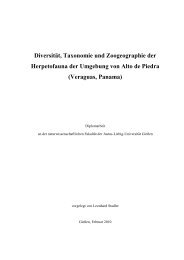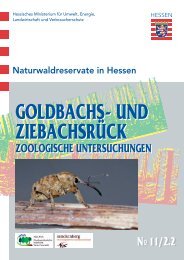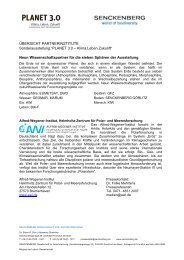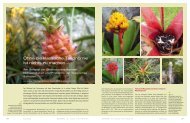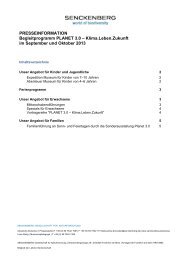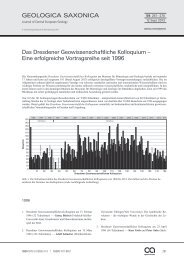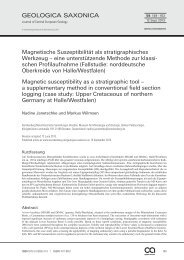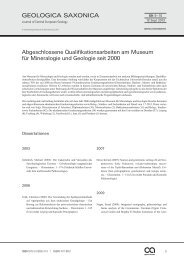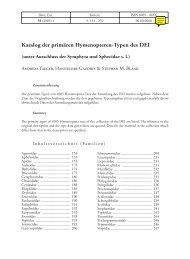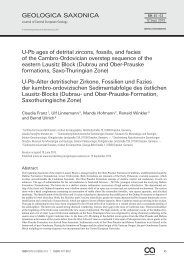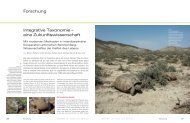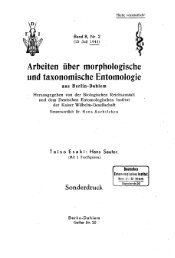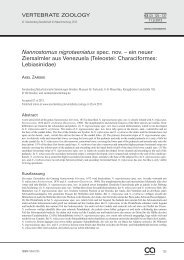Taxonomic publications: past and future - Senckenberg Museum
Taxonomic publications: past and future - Senckenberg Museum
Taxonomic publications: past and future - Senckenberg Museum
Create successful ePaper yourself
Turn your PDF publications into a flip-book with our unique Google optimized e-Paper software.
Burckhardt & Mühlethaler (eds): 8 th GfBS Annual Conference Abstracts 16<br />
Loss of phylogenetic information in histone genes because of gene conversion<br />
<strong>and</strong> GC3 drive? A data analysis of mammals <strong>and</strong> l<strong>and</strong> snails<br />
G. F. J. Armbruster & M. Böhme<br />
Replication-dependent histone genes occur in all eukaryotes <strong>and</strong> provide essential<br />
proteins for cell division. Histone gene sequences are often used in phylogenetic<br />
reconstructions of animal <strong>and</strong> plant taxa. We give an introduction on genomic<br />
arrangement of histone genes, <strong>and</strong> put the focus on gene conversion <strong>and</strong> GC3 drive<br />
mechanisms. GC3 drive, i.e., the enrichment of G or C nucleotides at the third,<br />
“wobble” codon position in protein-coding regions, is a favorite explanation why<br />
mammals (human, mouse) have high GC3 values in histone gene copies. This<br />
process seems to be influenced by conversion of chromosomal neighbours of histone<br />
genes of identical function (Galtier, 2003: Trends in Genetics, 19: 65-68). Because of<br />
these mechanisms of neighbouring loci, histone gene families of mammals are<br />
subjected to a loss of phylogenetic signals (i.e., loss of A or T nucleotides at the third<br />
codon position). This loss of phylogenetic information at the third codon position<br />
usually does not alter the amino acid sequence due to the degenerated code of<br />
“wobble” bases. Hence, GC3 mechanisms are not correlated with a shift to another<br />
amino acid sequence.<br />
We then present data of the partial Histone(H3)-spacer-Histone(H4) gene cluster of<br />
l<strong>and</strong> snails. We did not find clues for strong G or C enrichment at wobble base<br />
positions. Hence, phylogenetic information with A <strong>and</strong> T (<strong>and</strong> C <strong>and</strong> G) nucleotides<br />
was still found in the H3-H4 sequence alignment. At least two hypotheses are<br />
relevant for discussing putative histone gene differences of l<strong>and</strong> snails <strong>and</strong><br />
mammals: 1) L<strong>and</strong> snails have another arrangement of histone gene copies on their<br />
chromosomes <strong>and</strong>, hence, they might not have the typical “neighbouring” effect as<br />
mammalian histone gene cluster; 2) gastropods are poikilotherm animals,<br />
presumably with no strong constraint to enrich G or C nucleotides at the third codon<br />
position. Thus, a stabilizing shift of A/TG/C could be more likely necessary in warmblooded<br />
animals because of their higher body temperature. The latter hypothesis,<br />
however, is controversially discussed (Galtier, 2003: p. 67). The data analysis shows<br />
that phylogenetic information of protein-coding gene families can be influenced by<br />
gene arrangement, chromosomal neighbourhood <strong>and</strong> gene conversion.<br />
Org. Divers. Evol. 5, Electr. Suppl. 13 (2005)



